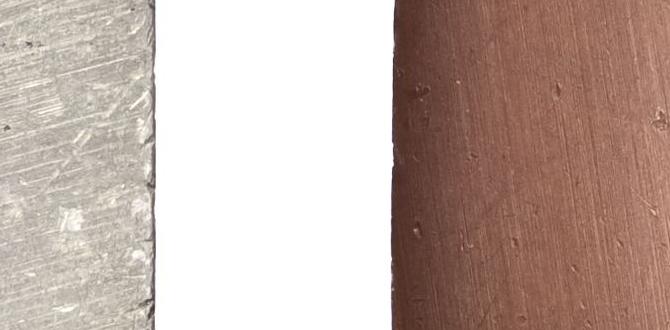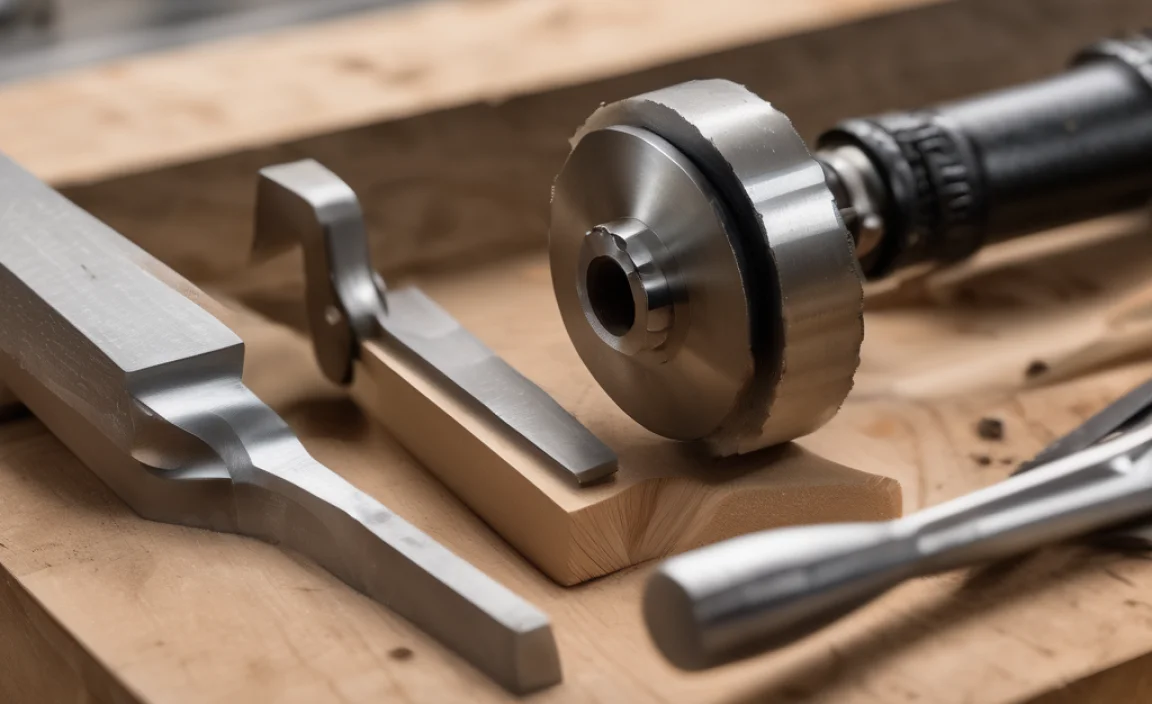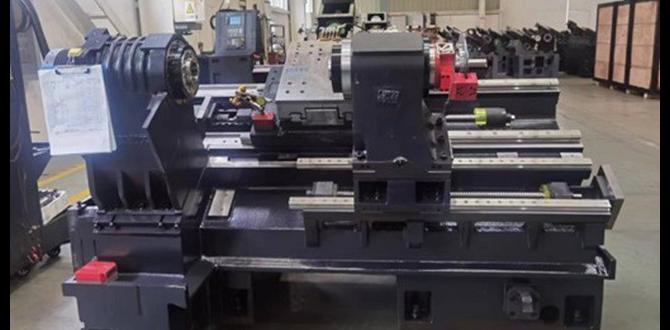A 1/8 inch carbide end mill is your key to precisely cutting and shaping fiberglass composites, offering durability and clean results for hobbyists and professionals alike.
Working with fiberglass can sometimes feel a bit tricky, especially when you need to make precise cuts. You might run into issues like rough edges or material chipping, which can be frustrating when you’re trying to get a project just right. Don’t worry, though! Many makers, from those just starting out in their home workshops to experienced hobbyists, find themselves looking for the best tools to handle fiberglass smoothly. The good news is, there’s a simple solution that makes this material much easier to work with. We’ll walk through exactly why a specific type of cutting tool is so effective for fiberglass, covering what to look for, how to use it safely, and what makes it a must-have for your toolkit. Get ready to tackle your fiberglass projects with confidence and achieve those clean, professional finishes you’re aiming for!
Why a 1/8 Inch Carbide End Mill is Your Fiberglass Best Friend
When you’re cutting into fiberglass, you need a tool that can handle its unique properties – it’s strong, fibrous, and can be abrasive. This is where a carbide end mill, specifically a 1/8 inch one, really shines. Unlike regular steel bits, carbide is incredibly hard and wear-resistant. This means it stays sharp longer and can cut through tough composite materials without quickly dulling or becoming ineffective.
For fiberglass, a 1/8 inch diameter is often ideal because it offers a good balance. It’s small enough for intricate details and precise cuts, but substantial enough for general milling and pocketing operations. When paired with the right flute geometry and a heat-resistant coating, these end mills cut through fiberglass cleanly, minimizing fuzzies and delamination, which are common headaches. This leads to smoother edges and a more professional finish on your projects, whether you’re building a custom part for a robot, creating intricate designs, or working on a boat hull.
Understanding the 1/8 Inch Carbide End Mill
Let’s break down what makes up an effective 1/8 inch carbide end mill for fiberglass and what specific features you should be looking for.
Key Features to Consider
When selecting your 1/8 inch carbide end mill, pay attention to these critical aspects:
Material: Solid carbide is king. Its hardness and heat resistance are essential for cutting fiberglass, which can dull softer metals quickly.
Flute Count:
2-Flute: Generally preferred for composites and plastics like fiberglass. The increased chip clearance helps prevent clogging and overheating, leading to cleaner cuts and reducing the risk of material melting or burning.
3 or 4-Flute: While good for metals, these can sometimes pack up more with softer materials like fiberglass, potentially leading to issues. For fiberglass, sticking with 2 flutes is often your safest bet for optimal performance.
Coating: A specialized coating can make a significant difference.
ZrN (Zirconium Nitride): Good for general-purpose machining, including composites. It adds hardness and reduces friction.
TiCN (Titanium Carbonitride): Offers excellent wear resistance and lubricity, which is beneficial for abrasive materials like fiberglass.
AlTiN (Aluminum Titanium Nitride): Excellent for higher-temperature applications and very hard materials. It can be a good choice for more demanding fiberglass cutting.
Uncoated Carbide: Still effective, but specialized coatings often provide enhanced performance and tool life in fiberglass.
Helix Angle: A higher helix angle (e.g., 45 degrees or more) can help with chip evacuation and create a smoother shearing action, which is beneficial for composites.
Shank: Standard is usually 1/4 inch, but for the keyword’s mention of “1/2 shank long reach”, that implies a tool with a 1/2 inch shank diameter and an extended length beyond the standard. A 1/2 inch shank provides more rigidity and vibration damping, crucial for longer reach applications and heavier cuts. A long reach allows you to cut deeper into materials or reach into recessed areas without the machine’s spindle being in the way.
End Geometry:
Square End: The most common type, suitable for general milling, slotting, and pocketing.
Ball Nose End: Creates rounded profiles and is used for 3D contouring and surfacing. For fiberglass, a square end is usually more versatile for typical cutting and shaping tasks.
Why the “Long Reach” Matters for Fiberglass
The “long reach” aspect of the end mill, often paired with a 1/2 inch shank, is particularly valuable. It allows the cutting head of the end mill to extend further from the tool holder. This capability is crucial for several reasons when working with fiberglass:
Deeper Pockets and Slots: You can mill deeper features without the spindle or tool holder crashing into the workpiece.
Accessing Difficult Areas: It helps reach into intricate designs or components where a standard-length tool wouldn’t fit.
Reduced Vibrations: A robust 1/2 inch shank provides greater stability and rigidity compared to smaller shanks, which is especially important for longer tools to minimize deflection and chatter.
Better Chip Evacuation: The longer flute length can allow for better airflow and chip removal, a critical factor when cutting composites to prevent overheating.
Heat Resistance for Fiberglass
Fiberglass, especially when cut at higher speeds, can generate heat. This heat can melt the resin binder in the fiberglass, leading to gumming up the cutting edges and producing a poor surface finish. Carbide end mills are naturally more heat-resistant than high-speed steel (HSS), but specific coatings like AlTiN further enhance their ability to withstand the temperatures generated during cutting. For fiberglass, prioritizing a heat-resistant material and coating is key to achieving clean, efficient cuts.
Setting Up Your Milling Machine for Fiberglass
Before you even touch your end mill to the fiberglass, proper setup of your milling machine is paramount. This ensures safety, tool longevity, and the best possible cut quality.
Choosing the Right Milling Machine
For a 1/8 inch end mill, you don’t necessarily need a massive industrial machine. Many desktop CNC machines, like those from Shapeoko, Inventables X-Carve, or even smaller Sherline or Taig mills, are perfectly capable. For manual milling, a benchtop mill is ideal. The key is a machine that has sufficient rigidity to handle the cutting forces without excessive flexing.
Clamping Your Workpiece Securely
Fiberglass can shift or move during machining if not clamped properly.
Workholding Methods:
Vises: A good milling vise is the most common method. Ensure the vise jaws have soft inserts (like aluminum or nylon) to avoid damaging the fiberglass surface if it’s a finished part you’re holding.
Clamps: Use hold-down clamps with t-nuts in your machine’s table slots. Distribute clamps evenly to prevent warping.
Double-Sided Tape: For thin sheets or templates, strong double-sided tape can work, but it’s best for lighter cuts.
Support: For larger or thinner sheets, place support blocks underneath the area being machined to prevent flexing and potential breakage.
Mounting the 1/8 Inch Carbide End Mill
The way you hold your end mill is critical for accuracy and safety.
Collets: Use a high-quality collet system. A dedicated 1/8 inch collet is best for a snug, accurate fit. Ensure the collet is clean and free of debris.
Tool Holder: If using a larger shank (like 1/2 inch), a matching collet chuck or end mill holder is required.
Runout: Minimize runout (wobble) as much as possible. Excessive runout leads to chatter, poor surface finish, and can break the end mill. Ensure your spindle and collet/holder are in good condition.
Optimizing Cutting Parameters for Fiberglass
Getting the cutting speeds and feeds right is crucial for a clean cut and preventing damage to both your material and your tool. Fiberglass can be tricky because the resin can melt, and the glass fibers can be abrasive.
Spindle Speed (RPM)
The optimal spindle speed depends on the material you’re cutting and the type of end mill. For a 1/8 inch carbide end mill in fiberglass:
Typical Range: You’ll generally be looking at speeds between 10,000 RPM and 25,000 RPM. Higher speeds are often better for softer materials like fiberglass as they create a finer chip and can help prevent melting, provided your machine can reach them and the chip evacuation is good.
Considerations:
Machine Capability: Make sure your machine can reliably and accurately achieve these speeds without overheating or excessive vibration.
End Mill Design: Coated, high-performance end mills can often handle higher speeds.
Coolant/Lubrication: If using a coolant or air blast, higher speeds are more feasible as they help manage heat.
Feed Rate (IPM or mm/min)
The feed rate is how fast the tool moves through the material. It’s just as important as speed for chip formation and preventing melting.
General Guideline: For a 1/8 inch carbide end mill, a good starting point for feed rate in fiberglass might be between 5 to 15 Inches Per Minute (IPM).
Chip Load: A more technical way to think about feed rate is chip load – the thickness of the chip each cutting edge removes. For fiberglass and a 2-flute end mill, aim for a chip load of approximately 0.001 to 0.003 inches per flute.
`Feed Rate (IPM) = Spindle Speed (RPM) × Number of Flutes × Chip Load (inches/flute)`
Example: 18,000 RPM × 2 flutes × 0.002 inches/flute = 72 IPM. You’d likely start slower and increase if the cut is clean.
Key Factors:
Depth of Cut: A shallower depth of cut allows for a faster feed rate.
Machine Rigidity: A less rigid machine will require slower feed rates to avoid chatter.
Cooling: Using air blast or a specialized coolant can allow for faster feed rates.
Depth of Cut (DOC)
How deep you plunge or step over with each pass.
Stepover: This is the amount the end mill moves sideways (X or Y axis) to mill a wider area. For fiberglass, a stepover of 20% to 50% of the end mill diameter (0.025 to 0.060 inches for a 1/8 inch end mill) is common. A smaller stepover generally results in a smoother surface finish.
Depth of Cut (Plunge): When plunging straight down into the material, use a shallow depth of cut, typically no more than 0.5 times the end mill diameter (0.0625 inches or 1/16 inch). For roughing or pocketing, you can often take deeper passes, perhaps 0.100 to 0.250 inches, depending on material thickness and machine rigidity.
The Importance of Chip Evacuation and Cooling
Chip Evacuation: This is CRITICAL for fiberglass. If chips don’t clear the flutes, they get recut, creating heat. This heat melts the binder in the fiberglass, gumming up the end mill and causing a rough finish.
Use Air Blast: A directed blast of compressed air at the cutting zone is highly effective.
Vacuum: A shop vac positioned to suck chips away can also help.
Peck Drilling: If plunging deep, use a pecking motion (plunge down a bit, retract to clear chips, repeat).
Cooling: While not always strictly necessary for fiberglass if speeds and chips are managed well, a light mist of cutting fluid or a specialized composite cutting lubricant can help keep temperatures down and reduce wear on the end mill. Ensure your machine is set up for wet cutting if you opt for this. For many home shop users, air blast is the most practical solution.
Safety First: Working with Fiberglass and End Mills
Machining fiberglass requires as much attention to safety as any other material. You’re dealing with sharp tools, dust, and potentially flying debris.
Personal Protective Equipment (PPE)
Eye Protection: Always wear safety glasses or a full face shield. Fiberglass dust can be irritating and sharp particles can fly.
Respiratory Protection: Fiberglass dust is a serious inhalation hazard. Wear a respirator mask rated for fine dust (e.g., an N95 or P100). Proper sealing is crucial.
Hearing Protection: Milling machines can be noisy. Use earplugs or earmuffs.
Gloves: Wear gloves to protect your hands from sharp edges and potential resin irritants. Nitrile or cut-resistant gloves are good options.
Clothing: Wear close-fitting clothing and avoid loose sleeves or jewelry that could get caught in the machine.
Machine Safety and Best Practices
Secure Workpiece: Double-check that your workpiece is clamped down securely before starting any cut.
Clear Area: Ensure the area around your milling machine is clear of clutter, tools, and flammable materials.
No Hands Near Moving Parts: Never reach into the machine’s working area while it’s powered on or the spindle is spinning. Use the machine’s controls from a safe distance.
Emergency Stop: Know where your machine’s emergency stop button is and how to use it.
Tool Inspection: Before each use, inspect your end mill for any chips, cracks, or signs of wear that could lead to breakage.
Start Slow: If you’re unsure about settings, always start with slower speeds and feeds, and shallow depths of cut. Increase them gradually as you gain confidence and observe the cut quality.
Dust Collection: If your machine has a dust collection port, connect it. For fiberglass, this is a primary way to manage hazardous dust.
Common Fiberglass Machining Scenarios and Solutions
Here are some common tasks where a 1/8 inch carbide end mill excels and how to approach them.
Pocketing and Recessing
Creating cavities or recessed areas in fiberglass sheets or parts.
Approach: Use a standard pocketing routine in your CAM software or a manual pocketing strategy. Employ a 2-flute, uncoated or coated carbide end mill.
Strategy:
Stepover: 30-50% of the end mill diameter (0.0375 to 0.06 inches).
Depth of Cut: Start with 0.100 to 0.250 inches, depending on machine rigidity.
Lead/Ramp In: Instead of plunging straight down, use a gentle ramp or helical plunge to ease into the material. This reduces stress on the tool and prevents breakage. A ramp angle of 2-5 degrees is usually sufficient.
Air Blast: Essential here to clear chips from the pocket.
Profile Cutting and Trimming
Cutting out shapes from a sheet of fiberglass, like custom panels or templates.
Approach: This involves cutting along an outline (2D profile).
Strategy:
Climb Milling vs. Conventional Milling: Climb milling (where the cutter rotates in the same direction as the feed) often gives a better surface finish and longer tool life in composites like fiberglass.
Lead/Ramp In: Similar to pocketing, ramp into the material to start if possible, or plunge at a very shallow angle.
Tab: For full cut-outs, leave small “tabs” (thin sections of material) connecting the part to the stock. You’ll cut these manually with a hobby knife or saw after the main profile is complete to prevent the part from moving unexpectedly as the last bit is cut.
Stepover: Not applicable for a single-flute path unless you’re doing adaptive clearing.
Engraving and Detail Work
Adding fine details, text, or complex patterns.
Approach: The 1/8 inch size is excellent for this.
Strategy:
Small Stepover: Use a very small stepover (e.g., 10-20% of diameter: 0.012 to 0.024 inches) to create smooth lines and avoid stair-stepping on curved engravings.
Shallow Depth of Cut: Keep the depth of cut shallow, perhaps 0.010 to 0.050 inches, for fine details.
Higher Speed: Often, higher spindle speeds with a controlled, slower feed rate work best for intricate detail.
Air Blast Crucial: To keep the small flutes clear and prevent melting, air blast is vital.
Comparison Table: Carbide End Mill Features for Fiberglass
| Feature | Ideal for Fiberglass | Notes |
| :—————– | :——————————————————- | :——————————————————————————————————————————————————————————————— |
| Material | Solid Carbide | Essential for hardness, heat resistance, and wear resistance against abrasive glass fibers. |
| Flute Count | 2-Flute | Best for chip clearance, reducing heat and preventing melting/clogging of resin. |
| Coating | ZrN, TiCN, AlTiN (or specialized composite coatings) | Enhances wear resistance, lubricity, and heat resistance, extending tool life and improving cut quality. Uncoated is acceptable but coatings offer higher performance. |
| Helix Angle | High (45°+) | Promotes better chip evacuation








